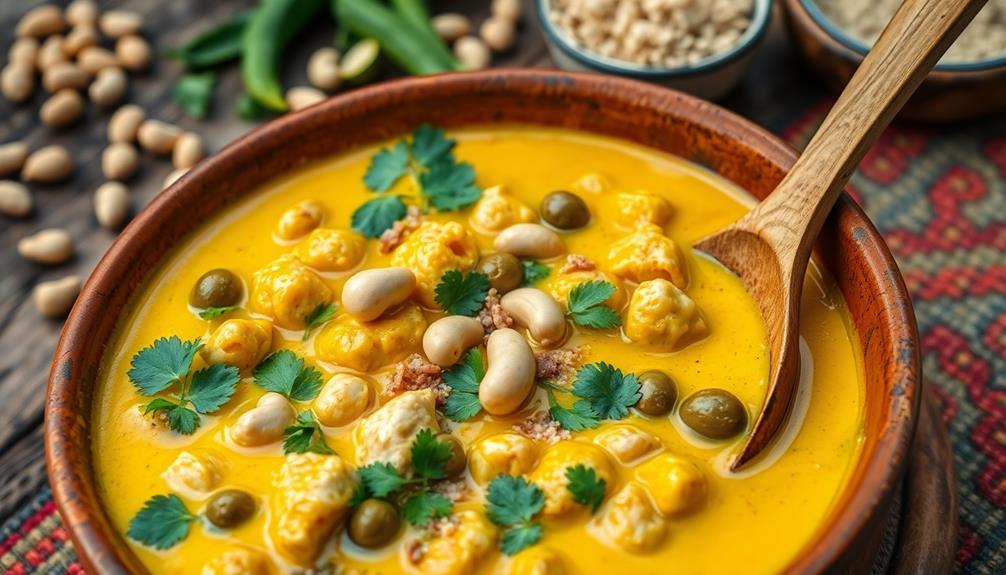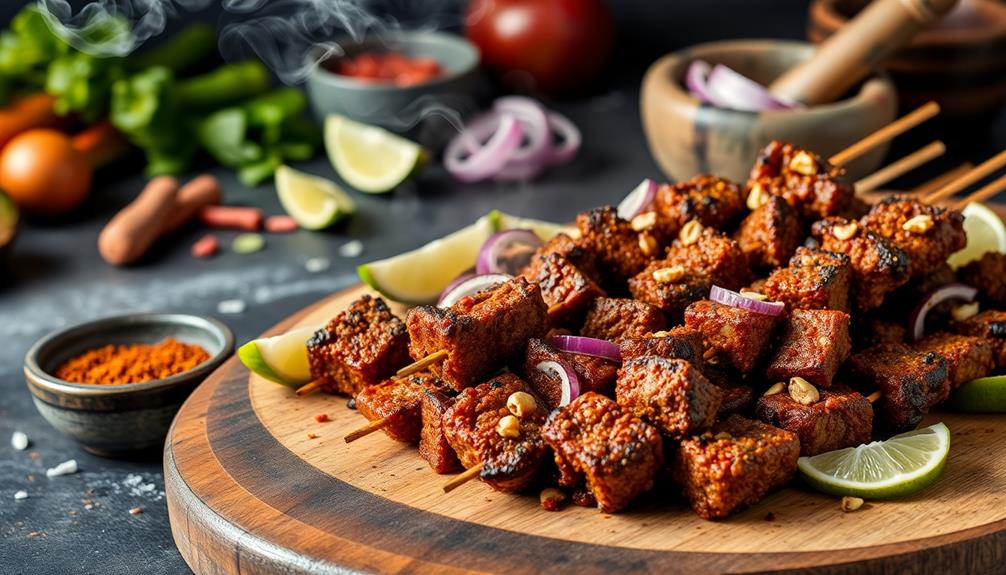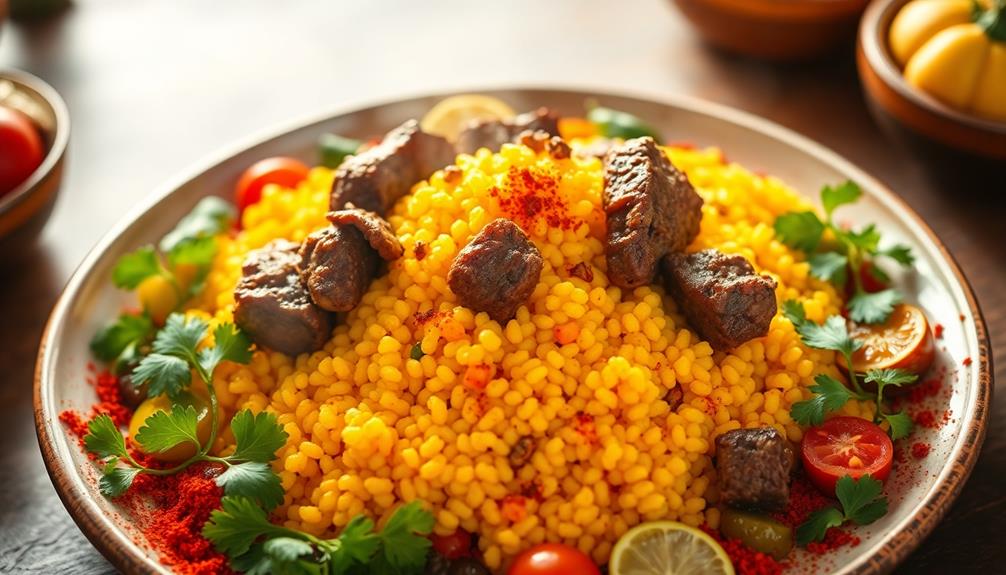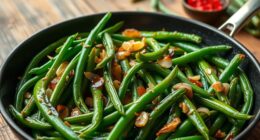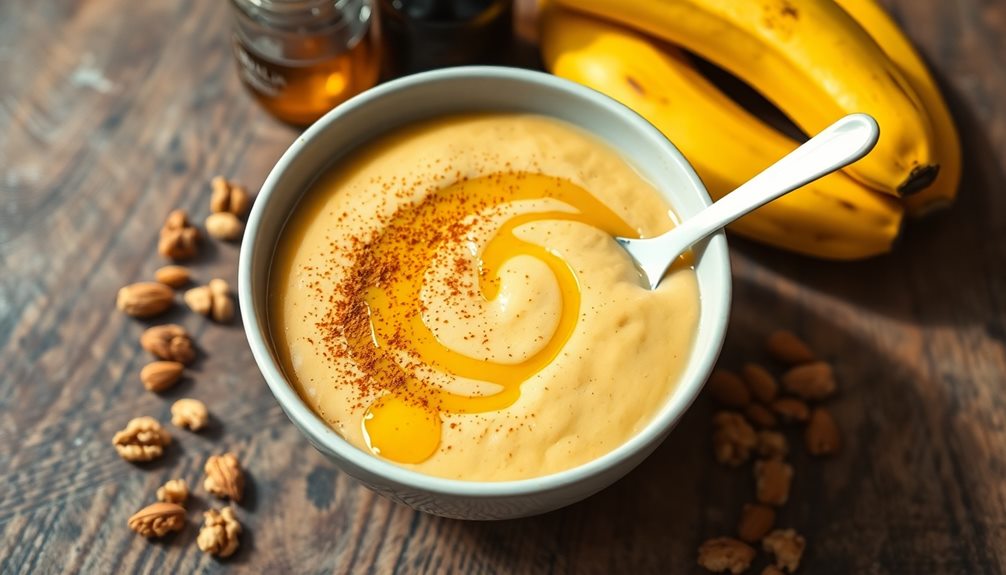You'll love alloco, a mouthwatering Ivorian street food made from crispy fried plantains that's both sweet and savory. This popular dish has been enjoyed for centuries in Ivory Coast and other West African countries. To make alloco, ripe plantains are sliced diagonally and fried until golden brown, creating a delicious snack or breakfast treat. It's often served with a spicy sauce made from hot peppers, onions, and tomatoes, adding a zesty kick to the sweet plantains. Alloco's unique flavor and texture make it a beloved comfort food that's perfect for sharing with friends and family. Discover the joy of this tasty Ivorian delicacy and transport your taste buds to West Africa!
History
For centuries, alloco has been a staple food in the Ivory Coast and neighboring West African countries. You'll find this tasty dish on street corners, in homes, and at local markets throughout the region.
Alloco's history is deeply rooted in the traditional cuisine of the Ivory Coast, where plantains have been grown and enjoyed for generations. As you explore the origins of alloco, you'll discover that it's more than just a simple snack.
It's a reflection of the country's agricultural heritage and the creativity of its people. The dish likely evolved as a way to make use of ripe plantains, which are abundant in the region's tropical climate.
Over time, alloco has become a beloved comfort food, often enjoyed as a quick breakfast or afternoon snack. You'll notice that its popularity has spread beyond the Ivory Coast, with variations popping up in other West African countries.
Today, you can even find alloco in African restaurants around the world, bringing a taste of Ivorian culture to global audiences. In addition to alloco, many African restaurants also serve traditional Ivorian dishes such as kedjenou, attiéké, and foutou. These dishes showcase the diverse flavors and ingredients that make up Ivorian cuisine and attract food enthusiasts from all over the world. Just like how alloco is bringing a taste of Ivorian culture to global audiences, traditional Mexican dried beef, known as carne seca, is also gaining popularity in international restaurants, introducing people to the rich flavors of Mexican cuisine.
Recipe
Alloco is a popular street food and side dish in Ivory Coast, made from fried plantains. This simple yet delicious recipe showcases the natural sweetness of ripe plantains, enhanced by a crispy exterior achieved through frying. Alloco is often served as a snack or accompaniment to main dishes, and it's a staple in Ivorian cuisine.
To prepare alloco, you'll need ripe plantains that are yellow with black spots, indicating their sweetness. The plantains are peeled, sliced, and then fried in hot oil until golden brown and crispy on the outside while remaining soft on the inside. Some variations include seasoning the plantains with salt or spices before frying, but the classic version relies on the natural flavor of the fruit.
Ingredients:
- 4 ripe plantains
- Vegetable oil for frying
- Salt (optional)
To make alloco, start by peeling the plantains and cutting them diagonally into 1/2-inch thick slices. Heat about 1 inch of vegetable oil in a deep frying pan or pot over medium-high heat. Once the oil is hot (around 350°F or 175°C), carefully add the plantain slices in batches, making sure not to overcrowd the pan. Fry for 2-3 minutes on each side, or until they turn golden brown and crispy.
Remove the fried plantains with a slotted spoon and drain them on paper towels to remove excess oil. If desired, sprinkle with a little salt while still hot.
For best results, choose plantains that are fully ripe with black spots on the skin, as these will be sweeter and softer when cooked. If you prefer a firmer texture, you can use slightly less ripe plantains. Be careful not to slice the plantains too thinly, as they may become too crispy and lose their soft interior.
Alloco is best served immediately while still warm and crispy, but can be reheated in an oven if necessary. Experiment with different dipping sauces or seasonings to add variety to this simple yet delicious Ivorian treat.
Cooking Steps
To make alloco, you'll start by slicing ripe plantains diagonally.
Next, heat some oil in a pan and carefully fry the plantain slices until they're golden brown and crispy.
Once they're done, drain the excess oil on paper towels and serve your delicious alloco with a spicy pepper sauce for a true Ivory Coast treat!
Step 1. Slice Ripe Plantains Diagonally

When preparing alloco, the first step is to slice ripe plantains diagonally. You'll want to choose plantains that are yellow with black spots, as these are the sweetest and most flavorful.
Start by washing the plantains and patting them dry. Then, carefully peel off the skin, which should come away easily if they're ripe enough.
Now, grab a sharp knife and cutting board. Hold the plantain at a slight angle and begin slicing it diagonally. You're aiming for pieces about 1/2 inch thick. The diagonal cut gives you larger, oval-shaped slices that'll fry up beautifully.
As you slice, you'll notice the plantain's soft, creamy texture and sweet aroma. Keep your fingers tucked away from the blade as you work your way down the plantain.
Once you've sliced all your plantains, you'll have a colorful pile of golden ovals ready for frying. The diagonal cuts will help the alloco cook evenly and create those delicious crispy edges everyone loves.
You're now ready to move on to the next exciting step in making this tasty Ivorian treat!
Step 2. Heat Oil in Pan

The next step in alloco's preparation involves heating oil in a pan.
You'll want to grab a large, deep frying pan or skillet and place it on your stove. Pour in enough vegetable oil to cover the bottom of the pan with about half an inch of oil. It's important to use enough oil so your plantain slices can swim freely when you add them later.
Turn on the heat to medium-high and let the oil warm up. You'll know it's ready when you see little ripples forming on the surface, or when a small piece of plantain sizzles gently when dropped in.
Be patient and don't rush this step! If the oil's too hot, your alloco might burn on the outside and stay raw inside.
While you're waiting, you can set up a plate lined with paper towels nearby. This will be your landing spot for the crispy, golden alloco once it's done frying. The paper towels will help soak up any extra oil, making your snack even more delicious!
Step 3. Fry Plantains Until Golden Brown

Now that your oil is hot, it's time to fry those plantain slices. Carefully place a few pieces into the pan, making sure not to overcrowd it. You'll hear a satisfying sizzle as the plantains hit the oil.
Watch them closely as they cook, and you'll see their color change from pale yellow to a beautiful golden brown. After about 2-3 minutes, use your tongs or a slotted spoon to flip the plantains over. They should be crispy and golden on the first side.
Let them cook for another 2-3 minutes on the other side. As they fry, you'll smell the sweet aroma of caramelizing plantains filling your kitchen.
Once both sides are evenly golden brown, it's time to remove them from the oil. Carefully lift each piece out and place it on a plate lined with paper towels. The paper towels will help absorb any excess oil, leaving you with perfectly crispy alloco.
Repeat this process with the remaining plantain slices until they're all fried to perfection. Your delicious Ivorian treat is almost ready to enjoy!
Step 4. Drain Excess Oil on Paper

After removing the golden-brown plantain slices from the oil, it's important to drain off any excess grease.
You'll want to prepare a plate or tray lined with paper towels or a clean kitchen cloth. Carefully transfer the hot plantains onto this surface, making sure they're not overlapping. The paper or cloth will soak up the extra oil, leaving you with crispy, not greasy, alloco.
Give the plantains a gentle shake or pat to help remove more oil. You'll see the paper absorbing the grease, which means less oil on your tasty snack!
Let them rest for a minute or two, allowing them to cool slightly and continue draining. If you're cooking a large batch, you might need to change the paper towels halfway through.
Once they've drained, your alloco will be perfectly crispy on the outside and wonderfully soft on the inside. The golden color will shine even brighter without the excess oil.
Now you're ready to serve and enjoy this delicious Ivory Coast treat! The crispy texture and sweet flavor will make your taste buds dance with joy.
Step 5. Serve With Spicy Pepper Sauce

Spice up your alloco experience by serving it with a zesty pepper sauce. This traditional accompaniment adds a burst of flavor that'll make your taste buds dance! To create the perfect sauce, you'll need a mix of hot peppers, onions, garlic, and tomatoes. Chop these ingredients finely and blend them together until smooth.
Next, heat some oil in a small pan and pour in your pepper mixture. Let it simmer for a few minutes, stirring occasionally. The aroma will fill your kitchen, making your mouth water!
Add a pinch of salt and a squeeze of lime juice to balance the flavors. Your sauce is ready when it's slightly thickened and the oil has a reddish tint.
Serve your crispy alloco alongside this spicy sauce in a small bowl. You can dip the plantains directly into the sauce or drizzle it over the top. The combination of sweet, crispy plantains and fiery pepper sauce is simply irresistible!
Don't be surprised if you find yourself reaching for more. Enjoy your delicious Ivorian snack!
Final Thoughts
Alloco stands out as a beloved culinary treasure in Ivory Coast. You'll find this tasty treat at street vendors, family gatherings, and even fancy restaurants. It's a dish that brings people together, no matter where you're in the country.
As you bite into the crispy, golden plantains, you'll understand why alloco is so popular. The sweet and savory flavors dance on your tongue, and the spicy pepper sauce adds an extra kick that'll make your taste buds sing.
It's a perfect snack or side dish that'll leave you wanting more.
You don't have to be in Ivory Coast to enjoy alloco. With a few simple ingredients and some practice, you can make this delicious dish at home.
Share it with your friends and family, and watch their faces light up as they experience the magic of Ivorian cuisine.
Frequently Asked Questions
What Are the Nutritional Benefits of Eating Alloco?
You'll get a good dose of potassium, fiber, and vitamins B6 and C from eating alloco. It's a source of complex carbohydrates and provides energy. However, it's often fried, so consume in moderation.
Can Alloco Be Made With Other Types of Bananas?
You can definitely make alloco with other banana varieties. While plantains are traditional, you'll find that ripe cooking bananas or even regular sweet bananas can work. Just adjust cooking times and seasoning to suit the type you're using.
How Long Does Cooked Alloco Stay Fresh?
You'll find cooked alloco stays fresh for 1-2 days when refrigerated properly. It's best to consume it within 24 hours for ideal taste and texture. You can reheat it in the oven or microwave before serving.
Are There Any Popular Dipping Sauces Served With Alloco?
You'll often find alloco served with spicy chili sauce or a tomato-based dip. Some enjoy it with mayonnaise or a garlic sauce. Don't forget to try it with attiéké, a popular side dish made from cassava.
What Drinks Pair Well With Alloco as a Snack or Meal?
You'll find beer, palm wine, or ginger juice pair excellently with this snack. If you're looking for non-alcoholic options, try fresh fruit juices like pineapple or mango. Coconut water's also a rejuvenating choice.

